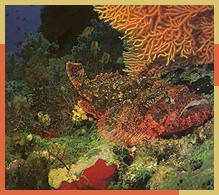Red
Sea Coast
FRINGING
REEF FORMATION
The
geological structure of the Red Sea, with a narrow coastal
shelf dropping off quickly into deep water, has constrained
the development of coral reefs, since reef-building corals
require shallow, warm water for photosynthesis by their symbiotic
algae (zooxanthellae). Rather than the large, offshore barrier
reefs found in areas such as Central America and Australia
where there is a wide, shallow continental shelf, Red Sea
reefs tend to be fringing reefs, forming a narrow band quite
close to the shoreline. The Gulf of Aqaba, on the east side
of the Sinai peninsula, is also deep and has this structure,
with fringing reefs along its coast. The Gulf of Suez on the
west side of Sinai is shallower, however it is influenced
by Mediterranean weather, meaning that the water gets sufficiently
cold to limit reef development.
REEF
DIVERSITY
Despite
these geological limitations to the extent of coral growth,
the Red Sea has a very rich and diverse coral fauna. Conditions
for coral growth are ideal. The climate is hot and arid, meaning
that the water is always warm and corals get a lot of sunlight.
Corals also grow best in water that is low in nutrients such
as nitrogen and phosphorus, because in nutrient-rich water,
algae grow rapidly and block the light. Hence low nutrient
water is very clear, while nutrient-rich water is murky. The
Red Sea surface waters are exceptionally clear and low in
nutrients because the hot, arid climate means that population
density is low and there is little nutrient input from soil,
agriculture and pollution on land. It also creates a permanent
surface layer of warm, nutrient-poor water which does not
mix with nutrient-rich deeper water (a process called "stratification").
Coral
reefs are particularly well developed in the north and central
Red Sea (Egypt, Saudi Arabia, Sudan). In the south, coral
growth is inhibited because nutrient-rich water from the Indian
Ocean enters the Red Sea, and because stratification is reduced
by very strong winds caused by the high mountains near the
coast. In this area, corals are less diverse and seaweeds
grow on top of the coral reefs during the summer. (Actually
it is quite rare to find coral reefs with
|

|
a
seasonal seaweed cover - the southern Red Sea and the south
coasts of Yemen and Oman are one of the few places were ithappens
regularly.) The Egyptian Red Sea supports about 200 species
of reef building corals in about 50 genera (no-one can give
an exact number since the taxonomic categorisation of corals
is difficult and controversial, and there are likely to be
species remaining undiscovered). This is about the same number
of species as the Maldives, Seychelles and other Indian Ocean
islands, rather less than the Great Barrier Reef and the western
Pacific Islands (about 300 species) but several times more
than the Caribbean.
Red
Sea fringing reefs are not only important for hard corals.
They support a highly diverse fauna and flora with almost
every group of animals and plants represented: algae, sponges,
cnidarians (corals, sea fans, jellyfish, anemones), molluscs
(e.g. octopus, shellfish, nudibranchs), crustaceans (e.g.
crabs, lobster, shrimp), echinoderms (e.g. sea urchins, starfish,
brittlestars), worms, tunicates ("sea squirts": organisms
that look a little like anemones and are our nearest invertebrate
ancestor) and of course vertebrates like fish, sharks, turtles
and dolphins.
BEHIND
THE REEF
The
fringing reefs form a barrier against the open sea, behind
which (except where the reef is very close to shore) is a
shallow protected lagoon. The lagoon will contain patches
of coral wherever there is a patch of hard bottom for corals
to attach to - they can be anything from a few metres to a
few 100 metres in diameter. These patch reefs are often even
more diverse and beautiful than the fringing reef itself,
since they are more protected from waves. The reefs are interspersed
with seagrass beds and sandy areas to form a mosaic of habitats.
If you dive or snorkel in these areas you will see different
animals in the different areas: e.g. juvenile fish, crabs
and nurse sharks in the patch reefs; starfish, sea cucumbers,
and occasionally baby reef shark in the seagrass beds; and
flatfish, stingrays and textile cone shells in the sandy areas
(beware the latter two: they have toxic stings).
 |
The
different species in each place might lead you to believe
that the ecosystems are separate. However in actual fact they
are highly interdependent, and this mosaic structure makes
each type of habitat more productive and diverse than it would
be if it existed in isolation. For example, many reef dwelling
species forage for food in seagrass beds at night when they
are safer from predation. If you are snorkelling or diving
on a reef, you will be rewarded by looking carefully in all
the cracks and crevices, where many of these species hide
out during the day. You are likely to find crabs, lobster,
juvenile grouper, moray eels and nurse sharks in reef crevices.
Try not to touch, knock or stand on the coral while you are
looking (it may be killed).
(Jo
Gascoigne)
|
|